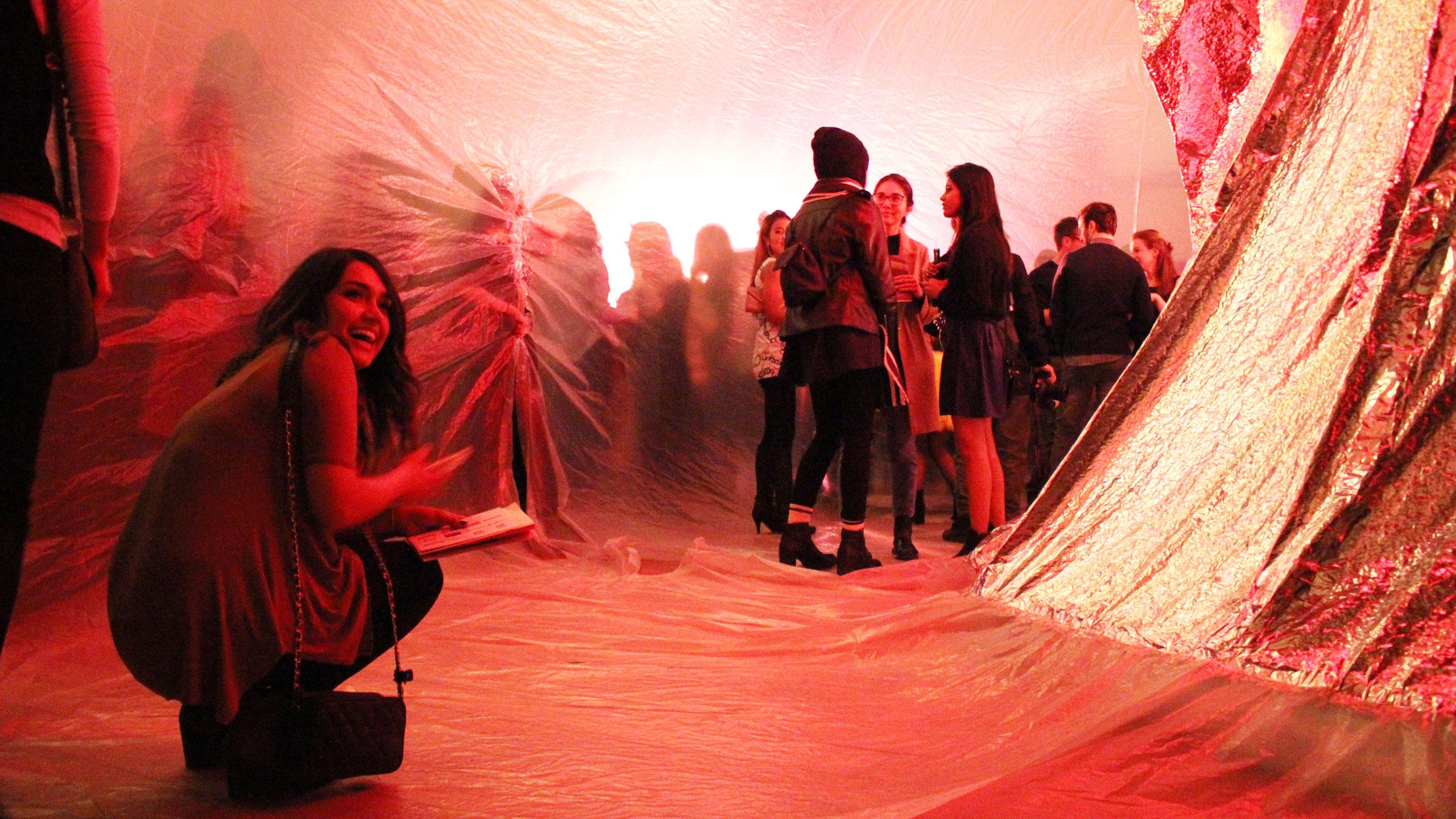By Izabella Balcerzak
A live DJ, beer and a giant, inflatable installation replaced the rows of pews and quiet meditation inside the church of the Holy Trinity on Jan. 16.
The task of designing the art piece for the Toronto Design Offsite festival’s launch event was assigned to a group of first and second-year architecture and interior design students. In the span of three months, a spatial art experience called PNEU—short for pneumatic—was created out of three simple materials: a space blanket, plastic sheeting and air.
“We were looking at form-finding and how architecture can create its own shape,” said second-year interior design student Dominique Di Libero, pointing to the air generator centered in the middle of the bubble art piece. “It’s a piece of pneumatic architecture.”
Red beams of lights were used to illuminate the silhouettes of those standing directly outside the structure to create the idea of “watching versus being watched,” said Di Libero. “When you’re on the inside you can see the silhouettes of the people outside, but you’re also mirroring them.”
[ngg_images source=”galleries” container_ids=”307″ display_type=”photocrati-nextgen_basic_slideshow” gallery_width=”864″ gallery_height=”486″ cycle_effect=”fade” cycle_interval=”5″ show_thumbnail_link=”0″ thumbnail_link_text=”[Show picture list]” order_by=”sortorder” order_direction=”ASC” returns=”included” maximum_entity_count=”500″]Rutuja Arte, second-year architecture student and co-designer, added that this effect created a special connection with the viewer and the space. “When we had this place in mind, we were thinking of creating this intimate experience because it’s such a large area and we wanted to bring people closer, yet when you’re inside, you still have a connection to the outside because of the transparency of this material. I think that’s what brings people in.”
Ryerson alum and executive director of the festival, Jeremy Vandermeij, suggested a collaboration with the festival and Ryerson students. The DMZ agreed, setting in motion the planning for a structure supported by air.
The students first used software like Photoshop and Illustrator to map out their design, followed by buying the material and sealing the structure in place. A convex pillar stood in the middle of the wheel-shaped bubble, partially made by a heat protecting material called mylar.
While the air they used is priceless and abundant, it did require some constant maintenance from the group. A small entrance hole was monitored as attendees entered to make sure the structure stood inflated. If it began to sag, the entrance would be blocked off for a few minutes, allowing for more air to fill the space.
“It was a very limited budget, which is why we went with this air theme and having air as our primary support because air is free. That was the way to go if we wanted to create this installation that had this large of an impact on people.” said Kelly Walcroft, second year interior design and co-designer of the project.
Standing in the crowd of dancing people, Marketing Director Michael Madjus glances over at the structure still beaming with constant silhouettes. He wants people to think about design differently. “Typically when people think of design, they automatically think of furniture or home decor, but they don’t think of it as a place such as this pneumatic space.That’s the beauty of this installation.”
Choosing venues such as the Holy Trinity Church is not unusual for the TO DO festival. The launch venue chosen last year was the Shopify office.
“I feel like by us choosing different venues, it gets people out to different spaces as well,” adds Madjus. “It’s a combination of old and new, design and art. It’s all magical. I realize there needs to be more room for stuff like this where we see things coming together and see how there are so many parallels. We live in a symbiotic universe.”
The collaboration of the two Ryerson schools are also bringing parallels into the design world. “Surprisingly the schools don’t collaborate that much. They’re starting to have more of these projects that are bringing students together,” said Di Libero.
From now until January 22nd, Toronto will be transformed by designers and emerging talent by the festival. It is Canada’s largest celebration of design and will feature over 100 exhibitions over central, east and west parts of the city.
PNEU was created by Ryerson students Dominique Di Libero, Gloria Zhou, Garbo Zhu, Rutuja Arte, Emily Allan, and Kelly Walcroft.











Leave a Reply